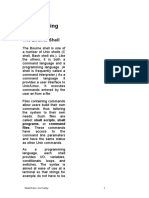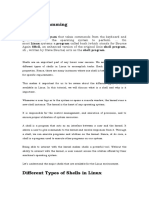Basic Linux Shell
Uploaded by
MansoorBasic Linux Shell
Uploaded by
Mansoor1.
The Basic Shells
1.1 Why Use Shells?:
Well, most likely because the are a simple way to string together a bunch of UNIX commands for
execution at any time without the need for prior compilation. Also because its generally fast to get a
script going. Not forgetting the ease with which other scripters can read the code and understand what
is happening. Lastly, they are generally completely portable across the whole UNIX world, as long as
they have been written to a common standard.
1.2 The Shell History:
The basic shells come in three main language forms. These are (in order of creation) sh, csh and ksh.
Be aware that there are several dialects of these script languages which tend to make them all slightly
platform specific. Where these differences are known to cause difficulties I have made special notes
within the text to highlight this fact. The different dialects are due, in the main, to the different UNIX
flavours in use on some platforms. All script languages though have at their heart a common core
which if used correctly will guarantee portability.
1.3 Bourne Shell:
Historically the sh language was the first to be created and goes under the name of The Bourne Shell. It
has a very compact syntax which makes it obtuse for novice users but very efficient when used by
experts. It also contains some powerful constructs built in. On UNIX systems, most of the scripts used
to start and configure the operating system are written in the Bourne shell. It has been around for so
long that is it virtually bug free. I have adopted the Bourne shell syntax as the defacto standard within
this book.
1.4 C Shell:
Next up was The C Shell (csh), so called because of the similar syntactical structures to the C
language. The UNIX man pages contain almost twice as much information for the C Shell as the pages
for the Bourne shell, leading most users to believe that it is twice as good. This is a shame because
there are several compromises within the C Shell which makes using the language for serious work
difficult (check the list of bugs at the end of the man pages!). True, there are so many functions
available within the C Shell that if one should fail another could be found. The point is do you really
want to spend your time finding all the alternative ways of doing the same thing just to keep yourself
out of trouble. The real reason why the C Shell is so popular is that it is usually selected as the default
login shell for most users. The features that guarantee its continued use in this arena are aliases, and
history lists. There are rumours however, that C Shell is destined to be phased out, with future UNIX
releases only supporting sh and ksh. Differences between csh and sh syntax will be highlighted where
appropriate.
1.5 Korne Shell:
Lastly we come to The Korne Shell (ksh) made famous by IBM’s AIX flavour of UNIX. The Korne
shell can be thought of as a superset of the Bourne shell as it contains the whole of the Bourne shell
world within its own syntax rules. The extensions over and above the Bourne shell exceed even the
level of functionality available within the C Shell (but without any of the compromises!), making it the
obvious language of choice for real scripters. However, because not all platforms are yet supporting the
Korne shell it is not fully portable as a scripting language at the time of writing. This may change
however by the time this book is published. Korne Shell does contain aliases and history lists aplenty
but C Shell users are often put off by its dissimilar syntax. Persevere, it will pay off eventually. Any sh
syntax element will work in the ksh without change.
Advanced Shell Programming Page 1
1.6 Read That Manual!:
On any UNIX system the on-line documentation available from the man pages covers all the
commands available, including the script languages. For Bourne it’s usually between 10 and 15 pages
whereas for C Shell or Korne it’s about 30 pages or more. It is a good idea to get this printed out and
put into a loose leaf folder. The on-line documentation is always more up to date than that in the
printed manuals that arrive with the system and if stored in normal A4 folders (I use the clear plastic
pockets to store the loose pages) this can be used as your reference source. People usually gasp in
horror when they hear this - “Why not just open a new window and use man!” - they cry. Well for one
thing, if I know the information I want is towards the back, I can jump straight to the page rather than
fight with the scrollbar. Secondly, if the information is wrong (Heaven Forbid!) or not too clear
(Really?), I can add some of my own clarification in the margins! The all important dialect or platform
specifics will also be listed within these man pages.
The other thing you must do is cultivate an ability to read through these man pages and understand the
meaning behind the words. This is a trick that takes time, don’t think for a moment that what is written
in a man page is actually correct. It is simply someone else’s idea of how to explain what is supposed
to happen under known circumstances. Don’t forget that it’s rare for the code writer to be the
documentation writer too. This ability will put you in good stead for negotiating the most troublesome
passages. If it doesn’t make sense the first time, change your view and look at it from another angle.
Develop this skill well, it will pay dividends later.
I have included some syntactical information from my man pages within this document but I have kept
it to the minimum required and always used examples to explain each concept, something sadly lacking
in man pages generally. All examples will be repeated for each shell for comparison when appropriate,
although I now only use Bourne shell full time because of its portability (See 6.3 and 6.5).
1.7 What is a Shell Script Anyway?:
A shell script, in its most basic form, is simply a collection of operating system commands put into a
text file in the order they are needed for execution. Using any of the shells mentioned so far, a text file
containing the commands listed in 6.7.1 would work every time the script was executed.
1.7.1 Example basic shell script
#!/bin/sh
rm -f /tmp/listing.tmp > /dev/null 2>&1
touch /tmp/listing.tmp
ls -l [a-z]*.doc | sort > /tmp/listing.tmp
lpr -Ppostscript_1 /tmp/listing.tmp
rm -f /tmp/listing.tmp
Of course not all scripts are this simple but it does show that ordinary UNIX commands can be used
without any extra, fancy scripting constructs. If this script was executed any number of times the result
would be the same, a long listing of all the files starting with lower case letters and ending with a doc
extension from the current directory printed out on your local PostScript printer. Not very exciting.
Lets start to look at this in detail starting at the beginning.
1.8 In the Beginning:
The first line of any script should always look a bit like the top line in 6.7.1, the only difference would
be the path leading to the shell executable file, in this case the /bin/sh part. By default the UNIX
system will attempt to execute an ASCII text file if the files name is supplied as the first argument on
the command line. UNIX will attempt to execute the file in the current shell, and try to process the
included command strings within the file using the syntax rules of the current shell. So, if you are using
the Bourne Shell as your default environment and the ASCII file contains a list of UNIX command
structures formatted how the Bourne Shell likes them to be formatted, all will work fine. However, if
you try and execute a C Shell file with a different syntax structure, the Operating System will complain
Advanced Shell Programming Page 2
about unrecognised commands and syntax errors. The reason is, no one told the Operating System that
it was a C Shell file, so it processed it as a Bourne Shell. The correct way to indicate this to the
Operating System is to pass the script name to the shell executable as an argument thus:
user@system$ /bin/csh my_script arg_1 arg_2
However, it didn’t take long for someone to notice that this was extra typing 1 that could well be done
away with and hence the short hand first Line comment was born (See - 7.2.3.1 ).
Basically, all comments in shell scripts start with a hash sign (#). However, for the first line only,
UNIX reads past the hash to see what’s next. If it finds an exclamation point (!), or Bang!, as it’s
known, then what follows is taken as the path to the shell executable binary program. Not only that, but
all the command line arguments that the shell executable allows can also be stacked up on this line (See
- 7.1 ). With this feature it doesn’t matter what flavour of shell your environment is, you can execute a
script in any other flavour of shell, as if it was a real UNIX command. Lets look at the Bourne Shell
syntax rules more closely. It would be helpfull at this point to print out the sh man pages from your
system so that you can compare them with what I have here.
1
There is a general rule among UNIX systems programmers that states - “Any command which has
more than two letters in it’s name, is too difficult to spell!”
Advanced Shell Programming Page 3
You might also like
- LSMW: BOM Upload Using Direct Input Method: OndayNo ratings yetLSMW: BOM Upload Using Direct Input Method: Onday36 pages
- Course Handout: (Last Update Thursday, 22-Mar-2012 12:43:56 EDT)No ratings yetCourse Handout: (Last Update Thursday, 22-Mar-2012 12:43:56 EDT)47 pages
- Experiment No. 6: What Is Shell Scripting?No ratings yetExperiment No. 6: What Is Shell Scripting?8 pages
- Instant Access to Learning the bash Shell Unix Shell Programming Third Edition Cameron Newham ebook Full Chapters100% (1)Instant Access to Learning the bash Shell Unix Shell Programming Third Edition Cameron Newham ebook Full Chapters67 pages
- Introduction To UNIX: Lecture Eight: 8.1 ObjectivesNo ratings yetIntroduction To UNIX: Lecture Eight: 8.1 Objectives9 pages
- Learning the bash Shell Unix Shell Programming Third Edition Cameron Newham - Download the ebook now to never miss important content100% (1)Learning the bash Shell Unix Shell Programming Third Edition Cameron Newham - Download the ebook now to never miss important content47 pages
- Part 1 Linux Chapter 5 Shell ProgrammingNo ratings yetPart 1 Linux Chapter 5 Shell Programming25 pages
- UNIX Shell Scripting Interview Questions, Answers, and Explanations: UNIX Shell Certification ReviewFrom EverandUNIX Shell Scripting Interview Questions, Answers, and Explanations: UNIX Shell Certification Review4.5/5 (4)
- Linux Shell Scripting Simplified: A Practical Guide with ExamplesFrom EverandLinux Shell Scripting Simplified: A Practical Guide with ExamplesNo ratings yet
- DDBoost Admin Guide 759-0017-0002 Rev A 2.5 PDFNo ratings yetDDBoost Admin Guide 759-0017-0002 Rev A 2.5 PDF114 pages
- The Application of Modern Critical Theor PDF100% (1)The Application of Modern Critical Theor PDF250 pages
- Emc Data Domain Networker Implementation Student GuideNo ratings yetEmc Data Domain Networker Implementation Student Guide96 pages
- CentOS - RHEL 7 - How To Change Runlevels (Targets) With SystemdNo ratings yetCentOS - RHEL 7 - How To Change Runlevels (Targets) With Systemd5 pages
- Backing Up and Recovering Clusters With Emc NetworkerNo ratings yetBacking Up and Recovering Clusters With Emc Networker41 pages
- CV10 Virtual Data Management Student Guide100% (1)CV10 Virtual Data Management Student Guide122 pages
- CV10 Core Fundamentals Course Student Guide - IndexCache Portion Is Very Wrong100% (1)CV10 Core Fundamentals Course Student Guide - IndexCache Portion Is Very Wrong181 pages
- B Migration To Ios XR 64 Bit - Chapter - 01No ratings yetB Migration To Ios XR 64 Bit - Chapter - 016 pages
- Presubmission Report Income Tax Calculator in C LanguageNo ratings yetPresubmission Report Income Tax Calculator in C Language3 pages
- Guidelines and Criteria: Short Papers at EGOS ColloquiaNo ratings yetGuidelines and Criteria: Short Papers at EGOS Colloquia2 pages
- Instant download Hands-on Microsoft Windows Server 2016 Second Edition. Edition Palmer pdf all chapter100% (3)Instant download Hands-on Microsoft Windows Server 2016 Second Edition. Edition Palmer pdf all chapter55 pages
- Simatic St80 Add Ons Complete English 2015 OkNo ratings yetSimatic St80 Add Ons Complete English 2015 Ok28 pages
- Which Aspect of The Email Is Least Indicative of A Phishing Attack? The EmailNo ratings yetWhich Aspect of The Email Is Least Indicative of A Phishing Attack? The Email8 pages
- 9601-0152 TechnicalBulletin SymmetryWEB v3 (3.1.12)No ratings yet9601-0152 TechnicalBulletin SymmetryWEB v3 (3.1.12)7 pages
- K14534: Creating SSL Certificates and Keys With Openssl (11.X - 13.X)No ratings yetK14534: Creating SSL Certificates and Keys With Openssl (11.X - 13.X)6 pages
- (Private Declarations) (Public Declarations) : ($R .DFM)No ratings yet(Private Declarations) (Public Declarations) : ($R .DFM)3 pages
- File UploadDownload Through NetWeaver GatewayNo ratings yetFile UploadDownload Through NetWeaver Gateway9 pages












































































































